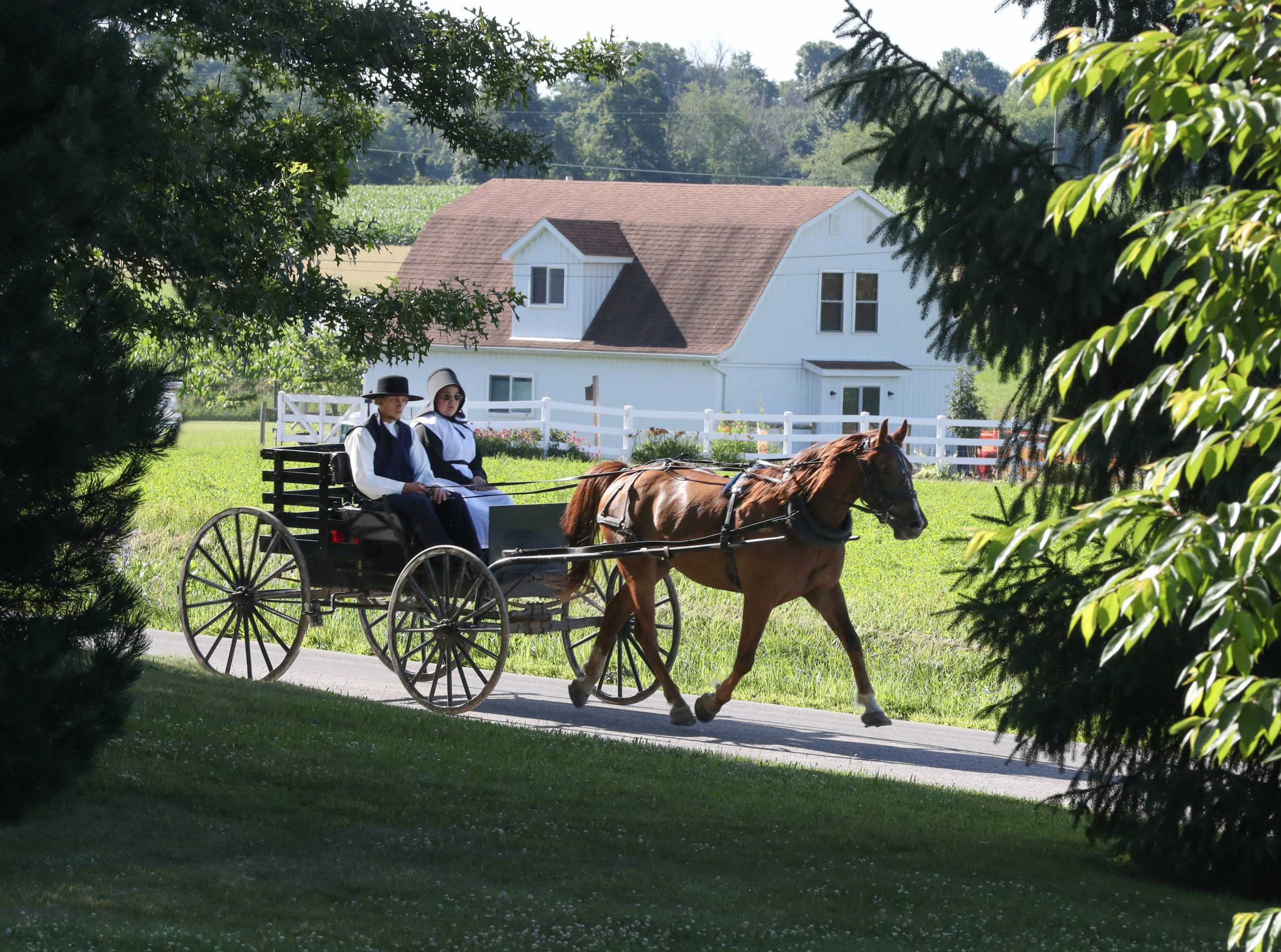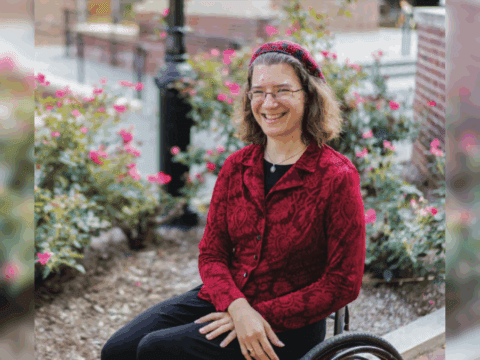MILLERSBURG, Pa. — The energy crisis. A pandemic. Sagging print newspaper circulation. One weekly tabloid newspaper in North America may be best equipped to cope with these vexing problems and it’s faith-based.
Die Botschaft is a weekly tabloid newspaper, loosely translated The Messenger, with a national circulation of 16,000. While its name is in Pennsylvania Dutch, the newspaper is printed in English and features letters, lots of letters, of about five- to-eight column inches in length, from across the nation.
On Wednesday, Aug. 18, the letter contributors, called “scribes,” are invited to a gathering at the offices of Die Botschaft for a full-course meal and fellowship. The scribes drive horse and buggies and regularly mail letters – many of them handwritten – to his office.

Novel newspaper nonplussed about typical newspaper woes
Die Botschaft grew 60 percent from 10,000 issues in 2005 to 16,000 today, says editor David Lapp from his office (next to his farm and house) in Millersburg, about 38 kilometres (24 miles) from Harrisburg.
The drive to his unadorned newsroom is serpentine. The road takes travellers over the treacherous Peters Mountain, past acres of corn, past a white-headed driver in a red MG, pass a helmet-less motorcycle rider with a neon orange shirt to the office on Deibler Road. The two-story building has no sign to indicate it’s anything, let alone a newspaper office, but inside is the newspaper operation that helps unite the national Old Order Amish community. The office also houses Lapp’s mail-order business, White Oak Naturals of herbals, hemp oil and more.
How is it possible that the Die Botschaft is growing while other print newspapers are losing readers every day?
One vital force is that Lapp’s audience — Old Order Amish — continue to grow in population. And, given that the community eschews technology, his print product fits the market demographic perfectly.
More on Broadview:
- Meet Linda Byler, the Amish romance novelist who didn’t know she’s a bestseller
- Generation Z offers a fresh perspective on journalism
“We’re going on like nothing happened,” said Lapp of the pandemic and the circulation woes of print newspapers. His audience is novel among readers even in the plain community—They are known for using horse and buggy for transportation and use cars and trucks only if driven by someone else.
Lapp talked about his unique publication from his recently constructed office with a US$65,000 solar panel system. He wore tan coloured suspenders and a lightly checked shirt, a pair of Croc-type shoes and the standard Old Order Amish beard and bowl cut. His eight-year-old son, Chester, stood nearby eyeing the conversation at a conference table.
21st Century journalism meets 17th Century journalism
As Lapp told the story of his newspaper that began as an offshoot of another publication around 1975, he often stopped chatting and asked the reason for an interview. For a newspaper editor, Lapp sounded as if he couldn’t understand why anyone would be interested in reading about his publication, printed in black and white with no photographs or the usual sensational trappings of a popular tabloid.
“You’re unusual. Your business model is novel. Your paper is growing while the industry is flagging.”
Lapp nodded his head and asked again, “Why are you doing this article?”
Perhaps the conventions of 21st-century journalism aren’t a match for a culture steeped in the 17th century?
Part of the confusion is the Old Order Amish directive not to seek the limelight and to protect the privacy of the community. Another explanation is that Old Order Amish are bound by traditions that originated in the late 17th century among followers of Jakob Ammann.
The Old Order Amish are known for being separate from the dominant society and cautious of technological innovations, according to Edsel Burdge, Jr., research associate at the Young Center for Anabaptist and Pietist Studies at Elizabethtown College.

Burdge said the sect continues to flourish. In 2020, about 340,000 Old Order Amish resided in about 560 settlements in the United States. Another 6,000 Old Order Amish live in Canada and about 200 live elsewhere.
Burdge said Old Order Amish grew by 20,000 people, or 6.25 percent, from 2000 to 2020 and he expects that trend to continue. That growth rate is lower than the overall U.S. population growth rate because of mass immigration to the U.S. But the birth rate for the Old Order Amish is more than triple the U.S. birthrate.
With growth comes readers, he said. When a new community is established, about 20 each year, a scribe – a volunteer writer – is needed to record life and Die Botschaft circulation grows, he said.
“They are very fast growing and they are a print culture; they are not reading on the web,” Burdge said, mainly because Old Order Amish avoid electronics such as the Internet.
Paul L. Graber, administrator of Lancaster’s Mennonite Information Center, said print newspapers unite the culture by keeping Old Order Amish in touch. “The newspaper has information that is interesting and helpful,” he said. “Readers can’t get that information anywhere else.”
He went on to say, “Paper communication is very important to them.”
Die Botschaft succeeds where other print publications fail
In a community that is cautious of technology, Die Botschaft is a maverick in the print industry. Its limited use of computers is strictly for business, but it is excelling despite that limitation.
According to Pew Research Center, the estimated total U.S. daily newspaper circulation (print and digital combined) in 2020 was 24.3 million for weekday and 25.8 million for Sunday, each down six percent from the previous year.
Brad Simpson, president of Pennsylvania News Media Association, said he is keenly aware of the benefit of weekly newspapers in his 320-member association.
“Weeklies are filling a void,” he said, adding that they often cover government meetings and high school sports and provide information that is missing from some more metropolitan products; however, advocacy newspapers and faith-based newspapers are not in the PNA membership.
For Lapp and his faith-driven publication, politics is not the content he seeks. His team of nearly 1,300 scribes send letters to his office on weather reports, births and folksy news and the readers love it. In return, scribes receive a free subscription.
Letters provide a diary-like account of Old Order Amish life
One letter to the editor July 9 said Die Botschaft is “clean reading.” While scripture passages are a small part of the content, the newspaper is popular with this religious audience. In the July 9 issue a reader wrote, “Keep up the good work.”
In early July, Mrs. Gideon Byler, Orrstown, Pa., wrote her letter, saying, “Seasons come and go and as long as we’re here on earth, we enjoy, take, love, or endure what God has created, which is a nice way of saying, ‘I endure summer, huh?’”
Mrs. Gideon Byler, also known as Linda Byler, is well-known in the Old Order Amish community for her 39 romance novels. ReligionUnplugged.com published her story July 2.
In the July 9 issue, Ivan M. Eva Martin of Ariss, Ont., wrote, “Greetings of love in Jesus holy name” and went on to talk about the weather and thunder and report that in Elmira, “the doughnuts and deli, (sic) closed.”
Other scribes such as Lillian Riehl of Bird-in-the-Hand, Pa., opened with the standard: “Warm Greetings sent around the Botschaft world.” Clemens W. Bontreger of Osseo, Wisc., began: “Hello to all in Botschaft land.”

Some scribes talk about the process of preparing an entry. Kathryn Martin of Elkton, Ky., reports at her kitchen table but tells readers that she tried writing on her porch instead recently, with no improvement, so she moved to the picnic table, “But Alas, Andrew isn’t working at this hot hour and he just keeps finding me [and] either he’s talking or he asks me what I’m writing. Who can write that way?”
Often the entries include an anecdote such as the one about tomato soup written by Mrs. Leonard Ray Zimmerman of Greenwood, Wisc., who said one of her sons volunteered to make the soup but admitted, “Mom, it is all foamy.” She wrote “I heaved myself out of the proch chair, leaving by peas behind and took a quick peek.” She picked up a container off the counter. “We had a good laugh and started over and used real tomato juice instead of ketchup.”
Scribes report news of men falling off of roofs, being trapped by a length of heavy fence that has fallen and the tragic accident of a girl hurt in a meat grinding accident. The reports tend to focus on how the accident could have been worse and emphasize God working in the lives of the readers.
Throughout the periodical are display advertisements that offer natural medicine products, medical assistance from Dr. Contreras Clinic For Dental Services to ads about infertility clinics and “Killer Monthly Cramps” at the Vital Health Endometriosis Center.
For the most part, the submissions are light-hearted and feature weather reports, wedding news and lines such as Clara Yoder’s of Hillsboro, Wisc.: “Daniel bought me a watch so I know when to come in for breakfast. Smile.”
Each week 800 or 900 of Lapp’s scribes submit handwritten letters and a team of typists from the Millersburg community keyboard them into a word-processor. Lapp uses an agent in India to help design and process the display ads that may be about auctions, stoves sales, roofing materials and other products or services – all for a national audience.
The media kit tells advertisers that Die Botschaft serves the Old Order Amish and Mennonite communities and is mailed every Friday to readers, estimated to be 30,000 people. Classified ads cost $12 per week for the first 30 words or less.” Caution. “We will not accept Ads with pictures of any person on the Ad” and “Raffles are not accepted in Die Botschaft Ads.”
The process of producing the weekly newspaper
When the content is ready, Lapp sends it to a Texas pagination service that prepares the 120 pages and sends it to a printer in Lancaster for distribution by U.S. Postal Service.
The postal service is the worst part of the job, Lapp said, adding that some readers receive their newspapers days late, sometimes weeks after it was printed because of the spotty mail service.
“Our product doesn’t get delivered,” Lapp said, his hands on top of his head.
“Paper communication is very important to them.”
A one-year U.S. subscription costs $52, $98 in Canada.
Lapp, 34, inherited the role of editor from his father, Elam Lapp, in 2005. Before that time, Lapp worked in vinyl fencing and helped construct gazebos, even working with his relative Mel Lapp, who now works as one of David’s staff.
Mel Lapp sat in the interview along with Enos King, who supervises display advertising. Mel kept his arms folded during most of the interview, sometimes stroking his long salt-and-pepper beard. Occasionally he offered one-liners.
The post office: “They do the best they can do.”
Controversy: “We’re human.”
Learning the craft on the job
Lapp learned on the job from his father following his eighth-grade education in Millersburg, a strong Amish community with about 400 members.
The publication received some national attention in 2006 after national news of a gunman who burst into a one-room schoolhouse and shot 10 Amish girls, killing five at close range, execution-style, with a nine-millimetre handgun. Elam Lapp told The Los Angeles Times that “we might mention that it happened,” but the long-standing policy of the paper was to avoid stories about murder, war, love or religion.
“Soon it’s going to drop out of the scene,” Elam Lapp told the Times, emphasizing that the Amish aim to forgive and move on. “It’s really not important to point out all the knickknack items.” When scribes’ letters come in referring to a gunman, for instance, “we just talk about the tragedy in the schoolhouse,” he said. “We don’t want to get into too much talk about gunmen.”
Strangely, many Americans criticize the news media for focusing on negative happenings – crime, war, politics, conflict. Major foundations have sponsored initiatives around more solutions-oriented journalism and community-oriented journalism. The Amish have been practicing that kind of journalism for a long time.
David Lapp says he aims to continue the tradition of positivity with his audience, staff and contributors. “I try to be encouraging,” David Lapp said of his management style with his scribes and others.
This approach is working, says communication scholar Diane Zimmerman Umble, a Mennonite who conducted extensive research on communication practices of Amish and Mennonite cultures. Along with David L. Weaver-Zercher she edited “The Amish and the Media,” published by the Johns Hopkins University Press in 2008.
“News from Die Botschaft doesn’t have competition from other media,” she said, adding that families where she resides often receive a daily newspaper or a periodical related to their livelihood such as Lancaster Farming.
Old Order Amish also are frequent public library users.
Support of the public library is one of the few local political issues for which the Amish communities may turn activist and offer a vote of support if a referendum is called, said Milo G. Miller, 42, publisher of The Budget newspaper, a rival publication that includes news for Mennonites and Amish communities.
Limited competition
The Budget began in 1890 in Sugarcreek, Ohio, and, according to “The Amish and the Media,” it served a religiously mixed clientele including the more liberal New Order Amish, a group that split from the larger church in the 19th Century. It’s circulation was 18,000 in 2013, according to a story in The Wall Street Journal.
“During the early years, former residents of Sugarcreek area—a few of whom were Old Order Amish—wrote letters to the paper as a means of keeping up contacts with old friends, thus establishing a precedent that would eventually come to dominate the paper.”
Miller said his national publication varies from Die Botschaft. The broadsheet is nearly 70 pages of content that is typed, copy-edited and paginated by his own staff in-house and costs $48 for an annual subscription. Like Die Botschaft, The Budget doesn’t have a website, normally a death knell in the digital era but a Godsend in the Old Amish Order.
Both newspapers encourage “feel-good” news and publish an index of each of the scribes’ town to help readers find specific letters. However, The Budget also includes pictures of people in ads, drawings by children and letters from a spectrum of Mennonites and Amish.
While David Lapp depends on a five-member national committee for guidance on his periodical, Miller is involved in secular organizations such as the National Newspaper Association and the Ohio Newspaper Association. His newspaper can sometimes be found on a rack stand at a general store in addition to postal delivery.
In his June 30 Publisher’s Corner, Miller noted that nearly 430 million pieces of mail are delivered by the U.S. Postal Service daily. Nonetheless, he wrote, “It’s reasonable to expect some errors and delays in moving over 400 million pieces of mail each day, after all, they are human, too, and deserve grace.” Miller said about 40 percent of his scribes fax their letters to him and about 10 percent use email and the other 50 percent sometimes have their contributions delivered a bit late.
While Miller isn’t Amish or Mennonite, he is active in his non-denominational, evangelical church and usually sees the King James Version used to quote scripture in his newspaper.
Friends bounded by ink and paper and a novel religious identity
Lapp said he and Miller meet about once a year and share ideas such as not sending all the writing supplies to the scribes all at one time — too wasteful.
Lapp said Miller liked that idea and said, “I may steal it.”
“We get along great,” said Miller. “No animosity.”
A few days after the interview, Lapp told Religion Unplugged that he is wary of an article about his publication and “people sticking their nose into our business.”
Despite Lapp’s take an article on his newspaper, he ended an email in typical Amish fashion: “Wishing you God’s blessings as you work for Him.”
Michael Ray Smith is a research fellow with LCC International University in Lithuania. He’s written nearly 3,000 articles and eight books. His Waynesboro, Pa., home is 86 miles from the office of Die Botschaft and surrounded by the plain community in rural Southcentral Pennsylvania. This story first appeared on Religion Unplugged.
















Can I place a notice in Die Bottschaft? I would like to contact the Amish community about some land I would like to give to them for settlement.
Hi Eli,
We don’t have a direct connection to Die Bottschaft — you would need to contact them directly!
Thanks,
Emma
Kindly provide email to receive news stories for the Die Botschaft Newspaper.
Thank You
Fred Hendricks